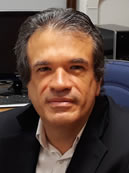 |
Hercilio G. de Melo, is a lecturer at the Polytechnic School of the University of São Paulo where he is responsible for the Electrochemistry Process Laboratory. He did his doctorate in aluminum corrosion at the University of São Paulo and at the Pierre and Marie Curie University in France and further post-doctoral in the Centre Inter Universitaire de Recherche et d'Ingénierie des Matériaux (CIRIMAT) in Toulouse, France. His research attention is in the investigation of metallic corrosion and its protection, with the majority of his research work being carried out using aluminum alloys as substrates. He coordinated several research projects sponsored by different foundations and agencies. Currently he participates in a thematic project supported by FAPESP for the study of corrosion of aluminum alloys welded using FSW and is a member of the RCGI network for CO2 abatement. Hercilio G. de Melo is member of the International Society of Electrochemistry and was co-chairman of the 10th Symposium on Electrochemical Methods in Corrosion Research. |
Hercilio G. de Melo
Polytechnic School of the University of São Paulo
Abstract
The use of friction stir welding (FSW) in large structures such as aircrafts, where aluminum alloys are extensively used, can result in significant weight reduction by allowing the removal of rivets and overlapping joints, positively impacting fuel consumption and reducing the emission of greenhouse gases. The procedure is a versatile green technology that can generate virtually defect-free welded joints, being one of the most significant developments in the technology for joining metals in the last decades. However, during the welding procedure, plastic deformation and heat generation occur in the weld region and in the surrounding areas. This results in the generation of three zones, namely, the stir zone (SZ) or weld nugget, the thermomechanically affected zone (TMAZ) and the heat affected zone (HAZ), with microstructures differing from each other and also with respect to base metal. Besides affecting the mechanical properties of the weld zones, the profound microstructural changes, including recrystallization, particles dissolution and coarsening and precipitation at grain boundaries, that take place in the weld affected regions may lead to modifications of the corrosion resistance of each of them individually as well as to galvanic coupling effects between them and also with the unaffected base metal. To correctly understand the corrosion behavior of these welded joints macro and microelectrochemical tests must be performed in close correlation with microstructural characterization. Examples are shown on the investigation of the corrosion behavior of the different brands of high strength aluminum alloys joined by FSW in the similar and dissimilar configuration. The importance of using local electrochemical techniques to unravel the electrochemical interactions at the microscale level is shown.